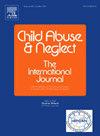了解照顾者因素在刚果民主共和国金沙萨男女青少年ACE变化中的作用:一项五波相关纵向面板研究
IF 3.4
2区 心理学
Q1 FAMILY STUDIES
引用次数: 0
摘要
童年不良经历(ace)是发生在0-17岁的创伤性事件,青春期是ace暴露增加的特别脆弱时期。目的:本研究探讨了照顾者在ACE变化中的作用,以及这些影响如何因性别而异。数据来自刚果民主共和国金沙萨两个资源不足的社区的1450名青少年(1083名在校青少年,367名失学青少年)。青少年在基线(2017年)为10-14岁,随访至2022年。方法对第1波(W1)和第5波(W5)的saces进行计数(0、1、2、3、4+)和类型(情感、身体、性、目睹家庭暴力、家庭功能障碍)评估。Wave 1中的三个护理者因素被纳入混杂因素/效果修饰因子。加权,有序逻辑回归和广义估计方程分析关联,按性别分层。结果W1组与W5组ace差异有统计学意义(OR: 0.4, 95% CI: 0.4 ~ 0.5)。对于男性来说,第一阶段照顾者的亲密性保护了他们在第五阶段的身体虐待(OR: 0.7, 95% CI: 0.6 - 0.99),第二阶段照顾者的舒适保护了他们在第五阶段的家庭暴力暴露(OR: 0.6, 95% CI: 0.4-0.9)。此外,W1时较低的护理人员监测与W5时较高的护理人员监测相比,ace变化更大。对于女性来说,照顾者的舒适度可以保护家庭免受干扰(OR: 0.7, 95% CI: 0.6-0.97)。结论W5期发生ace的几率较W1期低,照顾者因素起关键作用。性别分层分析强调需要量身定制的、基于优势的家庭干预措施,以减轻不良家庭行为并支持青少年的福祉。本文章由计算机程序翻译,如有差异,请以英文原文为准。
Understanding the role of caregiver factors on ACE changes between male and female adolescents in Kinshasa, DRC: A five-wave linked longitudinal panel study
Background
Adverse Childhood Experiences (ACEs) are traumatic events occurring from ages 0–17 with adolescence a particularly vulnerable period for increased ACEs exposure.
Objectives
This study examines the role of caregivers in shaping ACE changes over time and how these influences differ by sex.
Participants & setting
Data were drawn from 1450 adolescents (1083 in-school, 367 out-of-school) in two under-resourced communes of Kinshasa, Democratic Republic of Congo. Adolescents were aged 10–14 at baseline (2017) and followed through 2022.
Methods
ACEs were assessed by count (0,1,2,3,4+) and type (emotional, physical, sexual, witnessing domestic violence, household dysfunction) at Waves 1 (W1) and 5 (W5). Three caregiver factors from Wave 1 were included as confounders/effect modifiers. Weighted, ordered logistic regression and generalized estimating equations analyzed associations, stratified by gender.
Results
There was a significant change in ACEs between W1 and W5 (OR: 0.4, 95 % CI: 0.4–0.5). For males, caregiver closeness during W1 protected against physical maltreatment during W5 (OR: 0.7, 95 % CI: 0.6–0.99), and caregiver comfort during W1 was protective for domestic violence exposure during W5 (OR: 0.6, 95 % CI: 0.4–0.9). Additionally, lower caregiver monitoring at W1 was associated with greater ACEs change during W5 compared to higher caregiver monitoring. For females, caregiver comfort protected against household disruption (OR: 0.7, 95 % CI: 0.6–0.97).
Conclusion
There was reduced odds of experiencing ACEs during W5 relative to W1, with caregiver factors playing a key role. Gender-stratified analyses highlight the need for tailored, strengths-based family interventions to mitigate ACEs and support adolescent well-being.
求助全文
通过发布文献求助,成功后即可免费获取论文全文。
去求助
来源期刊

Child Abuse & Neglect
Multiple-
CiteScore
7.40
自引率
10.40%
发文量
397
期刊介绍:
Official Publication of the International Society for Prevention of Child Abuse and Neglect. Child Abuse & Neglect The International Journal, provides an international, multidisciplinary forum on all aspects of child abuse and neglect, with special emphasis on prevention and treatment; the scope extends further to all those aspects of life which either favor or hinder child development. While contributions will primarily be from the fields of psychology, psychiatry, social work, medicine, nursing, law enforcement, legislature, education, and anthropology, the Journal encourages the concerned lay individual and child-oriented advocate organizations to contribute.
 求助内容:
求助内容: 应助结果提醒方式:
应助结果提醒方式:


